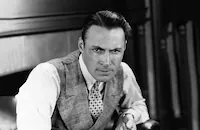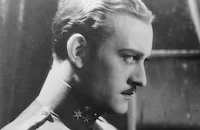One Romantic Night

Brief Synopsis
Cast & Crew
Paul L. Stein
Lillian Gish
Rod La Rocque
Conrad Nagel
Marie Dressler
O. P. Heggie
Film Details
Technical Specs

Synopsis
Because of political exigencies and his father's royal command, the fun-loving Prince Albert is persuaded to court the favor of Alexandra, daughter of the dowager Princess Beatrice. At her country home, Alexandra makes it clear to the prince that a forced marriage would be distasteful to her; and as a result, he tries to win her. Beatrice, piqued by her daughter's coolness, compels her to make a last effort to accept the prince by inviting Dr. Haller, an astronomer, to a ball planned in Albert's honor. Albert declares his love, believing Alexandra is in love with the astronomer, and realizing her love for the prince, she dismisses Haller. Albert announces he must wed a Princess Marie, but at Alexandra's suggestion he agrees to elope with her to South America.

Director
Paul L. Stein
Cast

Lillian Gish

Rod La Rocque

Conrad Nagel

Marie Dressler

O. P. Heggie
Albert Conti
Edgar Norton
Billie Bennett
Philippe De Lacy
Byron Sage
Barbara Leonard
Crew
Melville Baker
Melville Baker
John W. Considine Jr.
Park French
Frank Maher
William Cameron Menzies
Hugo Riesenfeld
Joseph M. Schenck
James Smith
Karl Struss
Herbert Sutch

Photo Collections
Film Details
Technical Specs

Articles
One Romantic Night
But the most notable thing about One Romantic Night is that it's Lillian Gish's very first talkie (or as Variety put it, her "first talker.") Critics were otherwise mixed, with Variety calling it "stiff and artificial... everything is stupidly blunt," and The New York Times deeming the film "highly satisfactory... This is Miss Gish's debut in vocalized pictures and it is gratifying to note that her voice records so effectively that it causes her screen work to be far more interesting than it was in silent productions."
Gish herself, however, was extremely dejected making this picture. For one thing, she did not get along with director Paul L. Stein. As she later said, "We had a director from central Europe whose work no one seemed to know. He was lacking in all but one of the three 't's so necessary in our world -- talent, taste and temerity. One could survive with two, but he had only temerity." She also said, "They never should have put me with a man like that." More significantly, Gish was unhappy because of her strong distaste for talking pictures in general. Part of the issue was technical, as she later told biographer Stuart Oderman: "I don't like the film. I don't know if I could watch it today. It was a first effort at acting in a sound film, and I was a veteran of silents.... The earliest silents had fluidity of motion, no matter how it registered on the screen. And they had beautiful music. It seems everything in One Romantic Night has to come to a stop to 'act' a scene using dialogue. The problems were technical, because of a lack of mastery of sound equipment. It wasn't the actor's fault."
The bigger part of the problem for Gish was philosophical. When the film came out, she toed the studio line and told gossip columnists that the talkies had saved the picture industry, but in more private outlets she let her real feelings be known. In a fascinating 1930 book edited by Oliver Sayler entitled Revolt in the Arts: A Survey of the Creation, Distribution and Appreciation of Art in America, three dozen "representative authorities" of different art forms contributed short pieces about their views of the current state of their art. Gish wrote a six-page piece entitled "On Behalf of the Silent Film." She began: "I may as well be very frank and admit at the outset that I do not believe in the sound film. Something very right, very true, very precious, was cut short on the verge of its ultimate and certain perfection by the intrusion of spoken dialogue and by the consequent throw-back of the cinema toward the theatre."
After relaying how silent screen acting had moved from broad pantomime to a point of beautiful subtlety, Gish continued, "All, or nearly all, of this skill and...technique was nullified when the cinema annexed speech in the talking picture. Oddly enough, the talking picture has served to call to our attention the most obvious flaw of the silent film. That flaw consisted in the fact that, even though our words were not heard or registered, we thought we had to speak lines while we were acting for the silent screen, lines at least generally associated with the action, even if they were not actually written or rehearsed. Just by exaggerating this custom and making words audible in the talking film, we have unexpectedly come to realize that words had nothing essentially to do with the silent film. If the silent film ever returns, it will owe this realization to the sound film."
In her lovely 1973 memoir Dorothy and Lillian Gish, she offered this eloquently personal reason for having distrusted the talkies: "It seemed so wrong to face a camera knowing that what I was doing could not be understood by most of my friends around the world. I had traveled enough to know how few could speak English and I felt I was betraying a trust (or I felt like a traitor to my followers). Communication in words belonged under the proscenium arch of a theatre, not in a tin box. Following this picture, offers were coming in to make other films, but since I did not sing or dance I made the big decision to go back to where I came from -- the theatre -- after a seventeen-year absence."
Indeed she did return to the stage. In fact, when One Romantic Night opened in May 1930, Gish could be seen on Broadway starring in Uncle Vanya. For the next twelve years, with the single exception of His Double Life (1933), Gish would work exclusively in the theater.
In addition to praising Gish, The New York Times commended the "splendid performance by Marie Dressler, who creates no end of fun [as] Princess Alexandra's mother, Princess Beatrice." The review also hinted at some technical sound problems that often plagued early talkies and which Gish had bemoaned: "Mr. La Rocque's voice issues much too loudly from the screen, and allowing for the fact that at this particular showing the reproduction of sound was invariably too boisterous, Mr. La Rocque's lines are hardly spoken as one might expect them to be."
For what it's worth, it should be noted that there is some question as to who actually directed what we see in One Romantic Night. The normally reliable Variety claimed in its review that director George Fitzmaurice was called in to reshoot much of the film after Harry D'Arrast had directed it. The review says Fitzmaurice didn't want screen credit and that it's unknown "where Stein fits in." However, it appears that Gish never publicly mentioned the existence of other directors and always referred to the credited Stein when speaking of the film.
Producer: John W. Considine, Jr.
Director: Paul L. Stein
Screenplay: Melville Baker (screenplay, adaptation); Maxwell Anderson (adaptation); Ferenc Molnár (play)
Cinematography: Karl Struss
Music: Hugo Riesenfeld (uncredited)
Film Editing: James Smith
Cast: Lillian Gish (Princess Alexandra), Rod La Rocque (Prince Albert), Conrad Nagel (Dr. Nicholas Haller), Marie Dressler (Princess Beatrice), O.P. Heggie (Father Benedict), Albert Conti (Count Lutzen), Edgar Norton (Colonel Wunderlich), Billie Bennett (Princess Symphorosa), Philippe De Lacy (Prince George), Byron Sage (Prince Arsene).
BW-72m.
by Jeremy Arnold
Sources:
Charles Affron, Lillian Gish: Her Legend, Her Life
Lillian Gish with Ann Pinchot, The Movies, Mr. Griffith and Me
Lillian Gish, Dorothy and Lillian Gish
Stuart Oderman, Lillian Gish: A Life on Stage and Screen

One Romantic Night
Quotes
Trivia
Notes
Other films based on the Ferenc Molnar play include the 1925 Famous Players-Lasky production The Swan, directed by Dimitri Buchowetzki and starring Frances Howard and Adolphe Menjou (see AFI Catalog of Feature Films, 1921-30) and the 1956 M-G-M production of the same title, directed by Charles Vidor and starring Grace Kelly and Alec Guinness.















